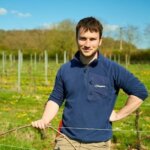Last month, after recording the lowest ever numbers in the 14-year history of their Big Butterfly Count, the Butterfly Conservation Charity declared a ‘butterfly emergency’. This is the latest grim figure to mark what adds up to an 80 per cent drop in butterfly numbers since 1976.
But it’s not just butterflies. We’ve all shared stories of how our drives through the countryside – which would once have left our windscreens covered with insects – now leave barely a mark. These anecdotes have now been backed up by numbers, with the Bugs Matter survey revealing that bug splats on windscreens after car journeys have plummeted by 89% over 20 years. Even DEFRA’s own reports now classify the long-term status of pollinators in the UK as ‘deteriorating’.
This loss of insects signals more than just a quieter countryside with cleaner windscreens. It’s hard to overstate the importance of our bugs – they form the trophic foundation that supports countless other species. The value of pollinators to UK agriculture alone is estimated at £690 million annually. Their decline doesn’t just affect nature, it threatens our food security, our health, our environments and our future.
What’s driving the decline?
At the heart of the decline in butterflies and other pollinators is how we farm our land. With 70 per cent of the UK classified as farmland, the way we manage this land is directly tied to the survival – or extinction – of these species.
The expansion of industrial farming has devastated our natural habitats. Once teeming with butterflies and bees, since 1930 the UK has lost 97 per cent of its wildflower meadows. Countryside roads named ‘Cowslip Lane’ and ‘Meadow View’ now overlook barren fields; the names seem to taunt us; reminiscent of a countryside that was once abuzz with varied insect life. The 2000 roads in the UK containing the word ‘meadow’ (or ‘dôl’ in Welsh) are a painful reminder of what farming once looked like. The damage goes beyond meadows – 118,000 kilometres of hedgerows have been ripped out since World War II, further fragmenting the habitats that insects need to survive.
Pesticide use, particularly neonicotinoids (or ‘neonics’) is another huge factor in pollinator decline. Neonics are horrifyingly toxic to insects – just one teaspoon is enough to kill 1.25 billion honeybees. These chemicals accumulate in ecosystems, affecting not only bees but other wildlife such as birds and fish.
Neonics are horrifyingly toxic to insects – just one teaspoon is enough to kill 1.25 billion honeybees. These chemicals accumulate in ecosystems, affecting not only bees but other wildlife such as birds and fish. Will White
Despite being banned in the EU for their clear link to pollinator decline, British sugar beet farmers have been granted exemptions to use neonics for four consecutive years, following successful lobbying by British Sugar and other big industry bodies.
Then there’s climate change. The signs of a warming planet are already starting to affect pollinators. Springs are wetter, winters milder, and our summers have seen increasingly long periods of drought. For butterflies, cold, wet weather can limit their activity and hinder caterpillar growth and survival. In drought conditions, plants can die off earlier than usual, reducing the food available for caterpillars and butterflies alike. Pollinators’ life cycles are often intricately tied to the seasons, and shifting weather patterns disrupt these timings – often creating ‘phenological mismatches’ where plant and pollinator are no longer active at the same time.
“Given the huge climate pressure on our vital pollinating insects like solitary bees, moths and butterflies, we need to do everything we can to reduce other harms,” urges Vicki Hird, Strategic Lead on Agriculture for The Royal Society of Wildlife Trusts. “It is unacceptable we have waited seven years for a National Action Plan on pesticides – this must be delivered soon and must ensure new measures – from better regulation and keeping banned insecticides banned to supporting farmers in using non-chemical pest and weed management, to reduce the harm rapidly whilst also ensuring we have healthy, diverse food supplies.”
What can be done?
The decline of pollinators is rooted in systemic issues within agriculture, shaped by decades of government policies that have prioritised cheap food production over all else. Since World War II, farmers have been paid government subsidies to maximise output. Hedgerows were torn out, habitats destroyed, and chemical inputs increased, all in the name of efficiency. Farmers were left with little choice but to follow suit or face financial ruin, pressured by unfair supply chains and tiny profit margins.
However, hope for our diminishing pollinators seemed to arrive with ELMs – England’s post-Brexit farming Environmental Land Management Schemes (ELMs), which are among the most progressive in Europe. These schemes reward farmers for public goods such as restoring habitats, planting wildflower margins, managing hedgerows, and eliminating pesticide use. Unfortunately, the rollout has been slow, with delays, dilutions, and bureaucracy causing frustration. Too many farmers are still waiting for the comprehensive support they’ve been promised to effectively transition to more nature-friendly forms of farming.
In the short term, the government’s most obvious step is to uphold the ban on pesticides proven to harm pollinators. Keir Starmer promised to do so, but recent reports suggest that ministers may backtrack under industry pressure. Backtracking on this commitment would be disastrous, not only for pollinators but for the government’s own target to halt nature’s decline by 2030.
“Pesticides are repeatedly identified as one of the key drivers of insect declines,” said Josie Cohen, Head of Policy and Campaigns, Pesticide Action Network UK (PAN UK). “If the new government wats to achieve its promise to restore nature, then it urgently needs to take action to reduce pesticide use and the associated harms. This should include the introduction of an ambitious pesticide reduction target, accompanied by increased support for farmers to help them transition over to non-chemical alternatives. The government must also stop granting repeat emergency permissions for all pesticides that have been banned due to the damage they cause, including bee-toxic neonicotinoids.”
Whether Labour deliver for farmers and pollinators alike is yet to be seen, but time is running out for the UK’s insects. What the government does next will determine whether we stop this devastating decline, or see it escalate, beyond the point of restoration.
What can we do?
We can all play a part in helping pollinators thrive again, whether it’s planting wildflowers in our gardens, supporting local farmers who use sustainable practices, or urging the government to hold firm on pesticide bans.
- Support conservation organisations: The Butterfly Conservation Charity, which runs the Big Butterfly Count, offers several ways to get involved. You can find out more at Butterfly Conservation.
- Protect meadows: Plantlife runs campaigns to protect and restore wildflower meadows, essential habitats for pollinators. Learn how you can support them at Plantlife.
- Say No to Neonics: The Wildlife Trusts have organised a petition urging the government to ban neonics for good. Currently, farmers who choose not to use neonics aren’t rewarded for their efforts, and British Sugar isn’t promoting neonic-free sugar. You can add your voice to the campaign here.
Will is the Sustainable Farming Campaign Coordinator at Sustain and has a background in implementing Agroecological farming methods and managing vineyards in Somerset. He’s previously worked on issues surrounding food poverty and is a dedicated advocate for nature-friendly farming and fairness across the entirety of the food supply chain.










I am sure I remember the Government proclaiming their new green credentials to protect our countryside and wildlife? Strange that they now appear to be listening to the blandishments of the sugar producers who seems set on using their awful chemicals to decimate our insect populations.
Thank you, Riverford growers and writers for campaigning against the continued destruction of our most valuable resources. Two war fronts also need shoring up:
1. Gardening contractors: Why aren’t they required to uphold a standard of training and certification like any other trade? Too many of them just rip through gardens with their machines and chemicals, overpruning at wrong times of year, destroying essential pollinator food and habitats for no good reason. Training should include an understanding of how to strengthen gardens to support our dwindling wildlife.
2. Gardening centres: They should not be allowed to dupe shoppers with labels like “pollinator friendly” on a plant dripping with neonicotinoids! They should also not sell glyphosate or other strong pesticides. People think it’s safe for every convenience or cosmetic change in the garden. It should be restricted to professional use as a last resort for intractably disruptive and prolific plants.
Our gardens, taken together, have to restore those lost meadows. So the services and consumer framework for garden maintenance need to be held accountable and made to stop their wanton destruction of the pollinator ecosystems in our own backyards.
I believe one of the main uses for Neonics is for the growing of sugar beet. Considering how bad sugar is for us why are we making such big efforts to grow sugar beets? Is it just to bolster the British Sugar industry?
It baffles me that people think they can harm and destroy one creature whilst not harming us all. Perhaps it’s because these are the little guys and us big people can treat them with impunity?
I find it truly phenomenal you have failed to mention how LED lights exterminate pollinators. Also, no mention of high frequency cell towers that also destroy lifeforms. In the 90’s it was found a cordless phone placed in a beehive with intermittent em frequencies disoriented the bees and within a week the hive was destroyed.
Climate change so 0.04% of our atmosphere is made of CO2 of which 0.0001% of that is so called human caused , of which only the minuscule developed world are trying to reduce. So for all that we should eat crickets and mealworms and reduce Gods creation of livestock and affect the carbon cycle. C02 is the gas of life, already the ppm values are very low, anymore and there will be mass extermination of people, perfect for the elite to get rid of useless eaters. Also, cell towers and electric cars run on 2.4GHz which is the same as microwave ovens, that is causing incorrect values of temperature in cities.
The icing on the cake for the climate hoax is the rich will carry on polluting our earth with their cruise ships, helicopters whilst offsetting the carbon; the layman will live in 15 minute cities, unable to travel,own anything and eat lab grown meat which uses serum from 150 pregnant cows at slaughter to get 2lbs of fake meat, so humane that. C02 levels are affected by temperature so if there are many sun spots more co2. It could be that we need more trees hence co2 is greater , leave the balance of nature with reasonable solutions where we respect animals and our environment, we are given a trust by God almighty to look after our own planet and everything on it, let animals eat what they are meant to eat , be human instead of allowing the people with money to get the best off the land. Also be warned SDG goals will eliminate any meritocracy in farming, small businesses will be out. Rosa Koire explains the truth behind SDG , it is not what you think. I tried to upload links but I was unable to so first link is from http://www.naturalscience.org section on radiation stress on plants and animals, also the bloody secret behind lab grown meat and Rosa koire UN sdg goals.